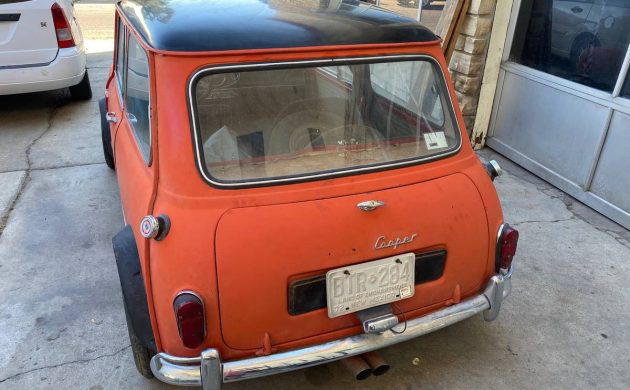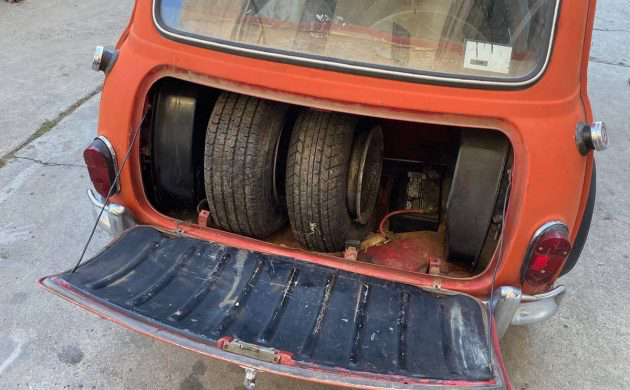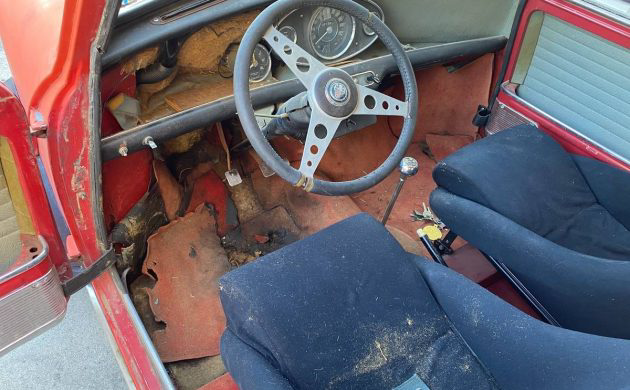The Mini was a successful sub-compact produced by British Motor Corporation (BMC) and its successors from 1959-00. It’s considered an icon in popular 1960s British culture. With the car’s space-saving transverse engine and front-wheel-drive layout, the Mini is considered one of the most influential cars of the 20th century, behind the Ford Model T. The Cooper S was the performance version of the auto, often found in rallies and races throughout the world. This one from 1967 has had just one prior owner from 1968 until (we believe) recently and was last registered in 2005 in New Mexico. Now located in Buellton, California, this former racer needs to be restored, but has good bones to start with. It’s available here on craigslist for $22,800. Thanks to Micheline Hughes for sending this tip our way!
To accommodate interest in rally racing at the time, Cooper Car Co. and BMC got together to offer the Mini Cooper from 1961-71. Because of its size, weight distribution, and drivetrain, the little cars won the Monte Carlo Rally in 1964, 1965, and 1967, along with many others. A more powerful Mini Cooper, dubbed the “S”, was released in 1963. Later featuring a 1275 cc engine and front disc brakes (rare for cars like this in the 1960s), Cooper S models built after 1966 had twin fuel tanks as standard equipment. Production figures are a little sketchy, but it looks as though about 19,000 Cooper S cars were built with that larger motor.
As the story goes, the seller’s Mini spent a lot of time on the racing circuit, but it hasn’t been street legal for the last 16 years. It doesn’t look too worse for the wear from that duty and the mileage of 40,000 is said to be correct. The original engine is still in place and the car will be sold with a spare race engine and front subframe. We’re told the only rust on the “S” is on the hood and its underpinnings are all very good and likely original. If you come to see the Mini in person, the seller will put it up on his lift for your inspection.
Because of its past, the original front seats are gone, and racing seats are there instead. The rear seat is also missing its backing. The car comes with documentation that supports its pedigree from the British Motor Industry Heritage Trust. Nailing down resale value is a bit hard to do, but the seller’s asking price seems to be within 85% of the average of the few recently recorded sales of these cars.






Other than a claim by the seller in the ad there is no evidence it was used as a race or rally car. The seats, which are about the only thing on the car with an aftermarket performance vibe don’t even have provisions on the side bolsters or bottom for lap belts or a crotch strap to pass through, which is what you see in even the cheapest plastic high back seats. Making an unsubstantiated claim about race history is akin to a seller claiming low production or mileage, they are often a ploy used to troll for suckers and line the sellers pockets.
Steve R
The roll hoop (rear only) seems to be in an odd place too, unless it isn’t currently bolted in. Minis’re fab; such a hoot to drive.
From what I’ve read, the original Volkswagen GTI was patterned after the Mini. I had a 1983 GTI, and with its beefed up suspension it was like a go-kart: stomp and steer.
My mum had a 1990 GTi (Mk2, big bumper); it was great fun, but wasn’t as talkative as a Mini. Or a 2CV, if it comes to that.
Mini has more rubber in it than the 2CV.
And if was truly a race car, it should have had the DOHC Cooper Climax engine, not the 1275.
Errr, not quite, Terrry. True racers retained the 4 Cylinder A Series Cooper S lump, which would have been bored to 1298cc for the 1300cc International Classes (Pre-65 there were also the 970S variants, bored to 999cc for the 1000cc International Classes). No DOHC units were ever used in the Mini and certainly not Coventry Climax units either. Carburation would either be single Weber dual choke, or split Weber 40’s. An 8 Port head was used towards the end of their lifetime to retain competitive edge.
Seller needs to provide some prof of race history.
Terry… Not true. The original Cooper Mini race cars used the 1275s in the majority of it’s races around the world. That said, I agree that this car had no race history other than a possible autocross.Pretty hefty price for not a whole lot.
I have heard that the BMW K series (motorbike) head bolts straight on to the A-series stud pattern. I don’t know if it’s true, but it’d be awfy interesting if it were!
Climax motors were always more associated with Imps.
There’s also the KAD 1440 twin-cam engine route; Fastest Mini In The World and all that. I think that it lives in Japan…
Having done a BMW K1100 head swap on my own Mini I can definitely say that the head decidedly does not have the same stud pattern as an original A-Series engine. Only two studs are close enough to keep and everything else, other than the cylinders, is either plugged and drilled to a new pattern or dry decked. It does go like stink now though!
Lives–guess its breathing then. haha Good one. More likely resides in place in Japan Your not the only one thinks that.
Anyone first timer buying a 1275S should have a good understanding of the word “hydrolastic”
Ad’s been pulled. Maybe seller took a look at the BF comments. Jim… those hydrolastic kits are still available as well as conversion kits to put the spring suspension on.
That Mini looks like it hasn’t seen the inside of a garage since 1967. As for the mileage claim, Well? Circus racer? I wonder where it could have been raced. I’ve been involve in road racing, in one way or another since 1965. I see no signs of any safety equipment. On photos, under the “bonnet,” also make me suspicious. The hydolastic suspension is the first thing to get replaced, with coil over suspension, on competition Minis.
What that car is good for is part for a vintage racing Mini and I can’t imagine anyone spending $20K for a parts car. I have friends that race them, I’d send this to them but, they might think that I’m insulting them.